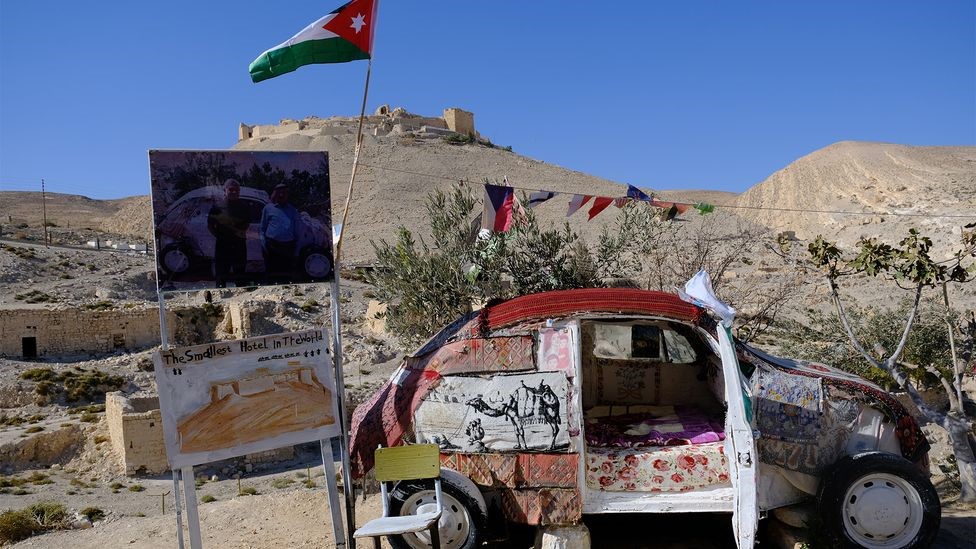A narrow, serpentine road, the King’s Road or Dar bar-Raseef, winds down through ridges and gorges. In case you’re wondering, I am not describing the famous street in London. This King’s Road is believed to be one of the world’s oldest continuously used roads. Pilgrims, warriors, and kings, travelled north to south through Jordan’s central highlands, and this thoroughfare served as a vital artery connecting ancient kingdoms and empires.
Today, a modern, tarmacked road (officially called Highway 35) sits atop its ancient ancestor. It runs south from Syria along the Jordan River, passing through Roman ruins, Byzantine mosaics, Crusader castles and the ancient city of Petra. It effectively reveals the history of Jordan, and links some of its most important historical sites.
“This route was used in the Nabataean period [4th Century BC to roughly 106AD], and probably even before that, in the Iron Age,” said Fawzi Abudanah, an archaeologist who has studied the region’s ancient road system. As Abudanah explained, since there is archaeological evidence showing Edomite, Nabataean, Roman, Byzantine and Islamic presence along much of the current highway, it suggests that this road has been in continuous use since at least the 8th Century BC. “We keep following the footsteps of our ancestors,” he said. It is even mentioned in the Old Testament of the Bible.
According to Abudanah, in ancient times, the King’s Road was an important trade route connecting Arabia, the Fertile Crescent, the Red Sea and Egypt. Caravans transporting incense and spices from Arabia took this road on their way to the thriving Nabataean capital of Petra. In the Roman period, Emperor Trajan (who reigned between 98-117AD) renamed the route Via Nova Traiana and paved it to accommodate wheeled carts. “We can still find Roman milestones on the side of the modern road,” Abudanah said.
Travelling south out of Amman, Jordan’s capital, you pass olive orchards, ripening pomegranates and rows of prickly pears – to the ancient town of Madaba. “The road crosses the most fertile part of the country, the area where you have springs and water sources, but also agricultural land. It’s the backbone of Jordan,” Abudanah told me.
Madaba is best known for its collection of Byzantine-era mosaics. The most famous of them, the remains of a 6th-Century floor mosaic housed in the modest St George Orthodox church, is considered the oldest surviving map of the Holy Land, and depicts various sites linked by the King’s Road.
Nine kilometres west of Madaba, a short detour from the King’s Road leads to Mount Nebo, where Moses purportedly first saw the Promised Land, and where he’s believed to have died and been buried.
Continuing south across the gently undulating plateau you reach the UNESCO World Heritage site of Umm ar-Rasas. Once a Roman garrison town, the site includes ruins from the Roman, Byzantine and Early Islamic periods.
Further on, the landscape becomes increasingly arid, and the medieval castle in the city of Kerak appears. Built in 1142, and retaken by Muslims in 1188, it is one the biggest and best-preserved Crusader fortresses in the Middle East.
More modern times impinge on the King’s Road at times. A curvy by-road in the arid hills leads to Mohammad “Abu Ali” Al-Malaheem’s “world’s smallest hotel” – a single room, battered Volkswagen Beetle lovingly decorated with his daughter’s embroidery. It’s become so popular, it has been visited by Jordan’s King Abdullah II.

After a slow, two-day, 250km road trip, you reach Petra, which was declared one of the New Seven Wonders of the World. Few places can rival the splendour of the ancient Nabataean city carved out of red sandstone in the arid desert. Petra was once a great mercantile city at the crossroads of empires and ancient trade routes, and the road used by Nabataean caravans that made the region prosperous is now trodden by tourists, including Indiana Jones, who come from all over the world to visit the site’s more-than-2,000-year-old temples, tombs and altars intricately carved into the narrow canyons.
The King’s Road not only showcases the most important phases of Jordan’s history, it also reveals an incredible collection of sites that range across almost three thousand years of continuous use. A definite bucket list trip, as long as you have a good security detail.